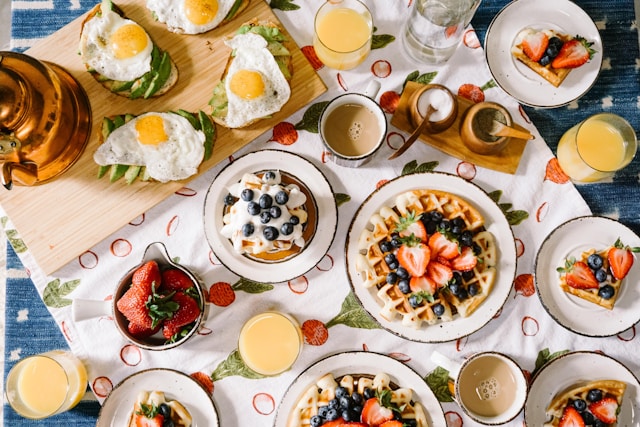
The History and Art of Making Crêpes
Crepes are a quintessentially French cuisine that has captivated taste buds around the world. Their thin, fine texture combined with their versatility to use a wide range of sweet and savory fillings makes them a popular choice for breakfast, brunch or dessert. You can have them with tea, coffee, or you can also have them with https://casinossinlicencia.org/ , and you’ll be fine! Let’s delve into the fascinating history and art of making these delicious treats.
History of Crêpes:
Crêpes trace their origins to the Brittany region in northwestern France. It is believed that this delicacy dates back to the 12th century when cereals were first used to make thin pancakes. Over time, the recipe evolved and gained popularity throughout France and beyond.
In Breton tradition, crêpes were an integral part of pagan celebrations marking the end of winter and the arrival of spring. The festivity, known as “La Chandeleur,” was celebrated on February 2nd, and crêpes were associated with prosperity and good fortune due to their round and golden appearance, resembling the sun.
The Art of Making Crêpes:
The preparation of crêpes may seem daunting at first, but with practice and patience, anyone can master this technique. Here’s a step-by-step guide to making delicious crêpes:
Ingredients:
- All-purpose flour: 1 cup
- Eggs: 2
- Milk: 1 1/2 cups
- Melted butter: 2 tablespoons
- Salt: 1/4 teaspoon
- Sugar (optional for sweet crêpes): 2 teaspoons
- Filling of your choice: Nutella, fresh fruits, cheese, spinach, ham, etc.
Instructions:
- In a large bowl, mix the flour and salt. Make a well in the center and add the eggs.
- Lightly beat the eggs and then gradually incorporate the milk, stirring until you get a smooth, lump-free batter.
- Add the melted butter and sugar (if making sweet crêpes) to the batter and mix well.
- Heat a non-stick skillet over medium heat and lightly grease it with butter or oil.
- Pour a small amount of batter into the hot skillet and quickly swirl the skillet to cover the bottom with a thin layer of batter.
- Cook the crêpe for about 1-2 minutes or until the edges start to brown. Then, carefully flip it over and cook the other side for another 1-2 minutes.
- Remove the crêpe from the skillet and repeat the process with the remaining batter.
- Fill the crêpes with your favorite ingredients and serve them hot.
Table of Suggested Fillings:
| Sweet | Savory |
| Nutella | Cheese |
| Jam | Ham |
| Fresh fruits | Sautéed spinach |
| Whipped cream | Sautéed mushrooms |
Interesting Facts About Pancakes
Pancakes are not only a delicious dish but also an object of fascinating cultural and historical heritage. Here are some intriguing facts about pancakes:
Ancient History: Pancakes have an ancient history dating back to pagan rituals. In Slavic and Scandinavian customs, pancakes were a symbol of the sun and spring, and they were cooked during the period of Maslenitsa to attract nature’s favor for the upcoming harvest.
International Popularity: Although pancakes are associated with Russian cuisine, they are popular worldwide. In France, they are called crêpes, in Germany – pancakes, in Italy – pancake, and in the USA – pancakes or flapjacks.
Variety of Fillings: One of the attractive features of pancakes is their ability to accommodate various fillings. They can be filled with fruits, berries, cheese, ham, mushrooms, vegetables, seafood, as well as sweet additions such as honey, jam, or chocolate.
Different Shapes and Sizes: Pancakes can be prepared in different sizes and shapes. From thin and large to small and thick, the variety of options allows you to choose the perfect version for any taste and preference.
Ceremonial Significance: In some cultures, pancakes play a ceremonial role. For example, in Russia, there is a tradition of tossing the first pancake, which is considered unsuccessful, to ensure success in cooking the rest of the pancakes.
Symbol of Maslenitsa: In Orthodox tradition, pancakes play an important role in the celebration of Maslenitsa, the last week before Great Lent. This holiday symbolizes bidding farewell to winter and welcoming spring, and pancakes are one of its main attributes.
World Record: In 2016, Russia set a world record for the number of pancakes cooked in one hour. Over 12,000 pancakes were cooked at the Maslenitsa celebration in the city of Yoshkar-Ola.
These facts are just a few of the things that make pancakes such a unique and beloved dish worldwide. They not only represent a tasty treat but also embody the rich history and cultural heritage of various nations.
Questions and Answers:
Q: What is the difference between crêpes and pancakes?
A: Crêpes are thinner and have a softer texture compared to traditional pancakes. Additionally, crêpes are typically larger and are rolled or folded with both sweet and savory fillings.
Q: Can crêpes be made without eggs or milk?
A: Yes, vegan crêpes can be made using alternatives such as almond milk or soy milk and replacing eggs with ingredients like mashed banana or ground flaxseed.
Crêpes represent a culinary delight that intertwines history, art, and flavor in every bite. Experiment with different fillings and preparation techniques to create your own versions of this French classic. Bon appétit!